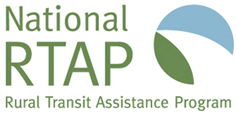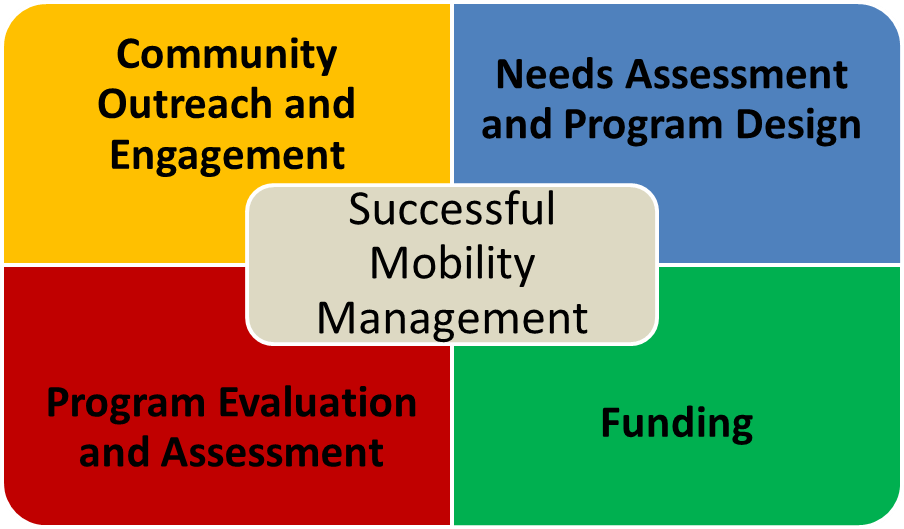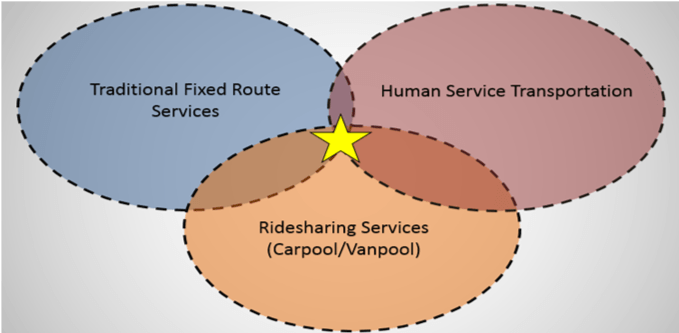FTA Funding for Mobility Management
Sections 5310 and 5311
Mobility management projects are eligible for capital funding under the Section 5310 and 5311 programs (providing up to an 80% federal share). A list of the types of activities that are eligible for mobility management capital funding can be found in the FTA circulars for each program. Because each state administers its Section 5310 and 5311 programs differently, transit managers should check with their State DOT for funding eligibility of mobility management projects in their area.
In every state, eligibility for Section 5310 funding requires that the project be included in a locally developed public-transit human services transportation plan. As noted previously, rural transit managers should be involved in the development of this plan, and some states require this for their Section 5311 program. For more information on the coordinated transportation planning requirements for FTA programs, see the
Planning and Evaluation section of the Toolkit, as well as FTA Circular 9070.1H. Again, transit managers should also check with their State DOT on state-specific coordination and planning requirements.
Through their RTAP contractor, New Hampshire DOT is planning to pilot a statewide mobility manager position that will be a new hire of the contractor that administers their RTAP. The Statewide Mobility Manager will serve as a liaison between state agencies and the Statewide Coordinating Council, Regional Coordinating Councils by assisting with hiring and training Regional Mobility Managers, and local transit providers. NHDOT is able to use Section 5311 RTAP funding for this role. For further information, see
Herlihy, Patrick, NHDOT. NH’s Mobility Management Framework. Presentation at MTAP Advances/State of Practice on Coordinated Transportation Plans. January 26, 2022.
Section 5312 and Section 3006(b) Demonstration Project Funding Programs
Enhancing Mobility Innovation Program
In November 2021, FTA announced the availability of FY2021 funding for the
Enhancing Mobility Innovation Program, which is authorized under Section 5312. This program builds on FTA’s previous mobility innovation investments (described below) and will fund projects that accelerate innovative mobility (such as innovative service delivery models, creative financing, novel partnerships, and integrated payment solutions) or that support the development of software solutions that facilitate integrated demand-response public transportation that dispatches transit vehicles through riders’ mobile devices or other means. On August 10, 2022, FTA announced the award of approximately $4 million in EMI grants. For examples of projects awarded under the program, visit
FY21 Enhancing Mobility Innovation Projects.
Accelerating Innovative Mobility Initiative
In FY 2020, FTA awarded 25 project grants under the
Accelerating Innovative Mobility (AIM) Initiative, using funding authorized under Section 5312. The primary objectives of the AIM Initiative are to foster innovative transit technologies, practices and solutions that advance the state of practice for public transportation in the U.S., leverage private sector investments in mobility for the benefit of transit, ensure innovative technologies and practices permit interoperability across systems and modes, and share results of innovative mobility solutions with the transit industry and stakeholders. For examples of projects awarded under the program, visit
FY20 Accelerating Innovative Mobility (AIM) Project Selections.
The
Innovative Coordinated Access and Mobility (ICAM) Pilot Program [Section 3006(b) of the FAST Act, administered by FTA as part of the Section 5310 program] funds innovative coordinated access and mobility projects for the transportation disadvantaged population that improve the coordination of transportation services and non-emergency medical transportation services. Eligible applicants are Section 5310 recipients and subrecipients. The Bipartisan Infrastructure Law, enacted as the Infrastructure Investment and Jobs Act, continues to provide funding for the Innovative Coordinated Access and Mobility (ICAM) pilot program. This program has also been referred to as Rides to Wellness as well as the
Transit & Health Access Initiative.
Mobility on Demand (MOD) Sandbox Program
The Mobility on Demand (MOD) Sandbox Program [49 U.S.C. 5312] is funding 11 demonstration projects across the nation to research new service options in combination with available technologies that allow for greater individual mobility. To provide an example of one of the projects, the Vermont Agency of Transportation (VTrans) developed a trip planner that provides access to flexible mobility options. This trip planner, which includes fixed route transit as well as demand response services, can be adapted for use in other areas. The final report on the VTrans demonstration project can be found on the FTA website. The resulting trip planner can be found on the Go!Vermont website.
Although the other MOD Sandbox projects are being conducted in large urban areas, the lessons learned from these projects are likely to be helpful for any area seeking information on new mobility options. Find out more about the MOD Sandbox program.
Integrated Mobility Innovation (IMI) Demonstration Program
FTA’s Integrated Mobility Innovation Demonstration program, initiated in 2019, brings together the MOD Sandbox demonstrations and several other FTA technology initiatives. In May 2019, FTA announced the availability of funding under the Integrated Mobility Innovation (IMI) Demonstration Program. Authorized under 49 U.S.C. 5312, the IMI program funds research in the three areas: Mobility on Demand (MOD) demonstration projects, Transit Automation (to explore the use of vehicle automation technologies in bus transit operations), and Mobility Payment Integration (MPI) research. The MPI area funds demonstration projects in two categories: Payment Equity and Human Service Transportation Coordination, and Integrated Mobility and Beyond, which will support multi-modal and multi-provider payment integration, including public transit, specialized transportation, and other modes of transportation. In March 2020, FTA announced FY 2019 IMI project selections.
Section 5314 Technical Assistance and Workforce Development Program
Tips from the Field – Two Case Studies
Case Study - Northern Arizona Council of Governments, Flagstaff, AZ
Northern Arizona Council of Governments (NACOG) is the regional planning agency responsible for facilitating transportation planning and mobility coordination activities in the vast rural areas of Apache, Coconino, Navajo, and Yavapai Counties. NACOG’s service area encompasses approximately 49,000 square miles (43% of Arizona). The land area is comparable to two states (Pennsylvania and Louisiana), thereby making NACOG the second largest Council of Governments in the United States. While the region is one of the largest in terms of land area, it is one of the least densely populated. Approximately, 530,000 individuals reside within the quad counties, equating to 11.3 persons per square mile, and comparable to the 45th least densely populated state.
In 2019, NACOG’s Mobility Management Planner, Tod Morris, shared the following thoughts on how mobility management can work in large rural areas and the different roles a mobility manager can play:
- Host Sub-Regional Coordination Meetings
- NACOG has divided the region into sub-regions based on similar political, cultural, and geographic similarities. Local coordination meetings are held to discuss operational issues, planning initiatives and grant opportunities. The intention for these meetings is for service providers and stakeholders to network and discuss shared challenges and collective opportunities. For new mobility managers, developing this type of structure is fundamental to fostering successful relationships.
- Utilizing Technologies
- Outside of the coordination meetings, the mobility manager also keeps in regular contact with partners in the region. Many times, travel is required for face-to-face meetings, but often teleconferencing is used to reach multiple agencies for specific initiatives. A valuable tool for these meetings is the ability to share screens using web-based technology such as GoToMeeting, Microsoft Teams, Adobe Connect or Zoom (Note, National RTAP does not recommend or endorse any specific product). Sharing a screen creates a more engaged conversation, especially when reviewing grant opportunities, service designs and needs analysis. Mr. Morris highly encourages visual tools such as maps or other graphics to better communicate strategies and ensure partners are on the same page. Mr. Morris has found that use of visual aids often fosters more robust conversations around passenger transportation priorities.
The Mobility Manager Role
In 2012, National RTAP reached out to former NACOG Mobility Management Planner, Jason Kelly, to discuss the many hats a mobility manager wears to build successful partnerships and enhance regional mobility. The seven hats below were outlined by Mr. Kelly as roles a mobility manager may need to play on any given day:
1. Coach/Mentor
2. Champion/Captain
3. Technical Advisor
4. Sounding Board to Providers
5. Planner
6. Artist/Salesman
7. Moderator/Facilitator
Adding on the Mr. Kelly’s list, current NACOG Mobility Management Planner Mr. Morris has found the following additional roles for encouraging and sustaining meaningful participation from regional stakeholders and service providers:
8. Educator: There are many exciting developments in the world of transportation. Partners are naturally curious about the progress and of services like Uber and LYFT and technical advancements like autonomous vehicles. In rural areas partners often turn to their mobility manager to learn the latest updates. Keeping up-to-date on these developments can help keep partners engaged and excited about their role in the changing transportation landscape.
Additionally, service providers can become frustrated by day-to-day challenges and wonder if other agencies are facing similar issues. Networking at national and local conferences and keeping an inventory of other transportation providers can help the mobility manager link with agencies that have addressed similar issues.
9. Interpreter: State and FTA documents and requirements can intimidate local transportation providers and stakeholders. Language on the rules and regulations of transit services can seem overwhelming and may even discourage agencies from pursuing new opportunities. A mobility manager can help agencies navigate compliance requirements and assess how they can be incorporated into a service. Furthermore, the mobility manager can help an agency evaluate their capacity to take on additional tasks and identify the feasibility of certain opportunities.
Mr. Morris echoed Mr. Kelly’s earlier statement that inactivity is stifling to progress. Identifying incremental objectives allows partners to tackle larger goals in a manageable and sustainable manner. Lofty coordination goals are a great example, where agencies can begin by sharing training and marketing opportunities, then grow into larger activities like vehicle and ride sharing.
Case Study – Tompkins Consolidated Area Transit, Ithaca, NY
Tompkins Consolidated Area Transit, Inc. (TCAT) s a not-for-profit corporation providing public transportation for Tompkins County, New York. In 2018, Tompkins County’s population was 104,000 people, with 51% living in the Ithaca urbanized area and 49% in surrounding rural towns. TCAT operates thirty-three (33) bus routes including one hybrid fixed/demand-response route. TCAT was formed in 1997 as a merger of the City, County, and Cornell University bus systems. TCAT reorganized as a private non-profit transportation corporation in 2005. Since 2012, TCAT’s ridership has exceeded 4 million passenger-trips and 1.5 million revenue miles annually, with a fleet of 53 buses. TCAT contracts with Gadabout Transportation Services, Inc. to provide ADA Complementary Paratransit service.
TCAT participates in mobility management programs guided jointly by the County Department of Social Services (DSS) and the Ithaca Tompkins County Transportation Council (ITCTC), bringing together a wide variety of service providers, agencies, and institutional actors to develop and improve community mobility services. Other partners include Cornell Cooperative Extension of Tompkins County (CCETC), the Center for Community Transportation, Inc. (carshare+), Cornell University, Ithaca College, Tompkins-Cortland Community College, as well as volunteer driver services, taxis, other service providers, the Ithaca Downtown county departments, and human service agencies.
Aside from a long-standing commitment to interagency collaboration and the joint leadership provided by ITCTC and DSS, three core principles have been at the heart of the effort to manage the changing mobility landscape in Tompkins County:
- A willingness to establish coalitions to assess and address evolving, unmet transportation needs, reinvent existing services, and adopt new mobility service models
- The creation of non-profit organizations to implement new mobility services and solutions arising out of collaborative efforts, typically with wide-ranging public, institutional and private sector participation; and
- The knowledge, ability, and willingness to share and coordinate all available funding sources to support the full range of mobility initiatives.
The services, programs, and initiatives currently underway include:
- TCAT: providing fixed route bus and rural demand response (DR) services and real-time bus location and arrival information to the public with smartphone apps, planning a rural first mile-last mile service pilot, installing Wi-Fi internet access on all buses and buying its first electric transit buses to begin a transformation to an electric bus fleet.
- Gadabout: integrating ADA paratransit service for TCAT with its county-wide demand-response service.
- The County: contracting for the Finger Lakes Rideshare program, led by ITCTC and supported by the Tompkins Rideshare Consortium.
- Cornell University and the Ithaca Downtown Alliance: operating their respective transportation demand management (TDM) programs.
- Cornell Cooperative Extension of Tompkins County (CCETC): providing the “Way2Go” community mobility education program and a one-call / one-click service.
- CCETC: operating Way2go’s MoveTogetherNY regional mobility management program to improve regional mobility for commuting and travel to healthcare in seven counties.
- County DSS: leading local stakeholders to develop a business model for a Mobility-as-a-Service pilot through participation in FTA’s Mobility On Demand On-Ramp Program.
A community consensus to collaborate, along with an entrepreneurial energy to improve, creates the fertile ground necessary for developing the wide breadth of services that TCAT and its partners provide now and plan for in the future.
Much of the text for this section was based on a former APTA web feature on TCAT, with updates made in 2018 in consultation with Dwight Mengel, Chief Transportation Planner for Tompkins County. For more information on TCAT, please visit the TCAT web site.
Section Sources
- APTA. Mobility Management Profiles- Ithaca and Tompkins County, NY
- Coordinating Council on Access and Mobility (CCAM) Federal Fund Braiding Guide
- Gustave Cordahi, Susan Shaheen, Elliot Martin. MOD Sandbox Demonstrations Independent Evaluation – VTrans Open Trip Planner Evaluation Plan, Final Report. USDOT FHWA-JPO-18-679, June 2018
- FTA Circular 9040.1H, Formula Grants for Rural Areas: Program Guidance and Application Instructions
- FTA Coordinating Council on Access and Mobility web page
- FTA Transportation Coordination web page
- FTA Program Fact Sheet under the Bipartisan Infrastructure Law
- FTA web pages on current grant programs under the FAST Act
- Herlihy, Patrick, NHDOT. NH’s Mobility Management Framework. Presentation at MTAP Advances/State of Practice on Coordinated Transportation Plans. January 26, 2022.
- KFH Group, Inc. Expanding Access to Our Communities: A Guide to Successful Mobility Management Practices in Small Urban, final report for National Cooperative Highway Research Program (NCHRP) Project 20-65 Task 68: Successful Mobility Management Practices for Improving Transportation Services in Small Urban and Rural Areas, 2018
- National Center for Mobility Management (NCMM) web site
- National RTAP, Sharing Training with Agencies Coordinating Transportation Best Practices Spotlight article
- NY Mobility Manager (mobilitymanager.weebly.com) Mobility Management in Tompkins County, NY web page
- Texas Department of Transportation. Texas Public Transportation Human Services Coordination Plan Guidebook, 2025
- Tompkins Consolidated Area Transit web site
- Transportation Technical Assistance Coordination Library (TACL)
- Communications with Tod Morris, Mobility Management Planner for Northern Arizona Council of Governments (NACOG), former NACOG Mobility Management Planner Jason Kelly, Dwight Mengel, Chief Transportation Planner for Tompkins County, and Patrick C. Herlihy, Director of Aeronautics, Rail & Transit, New Hampshire Department of Transportation
Suggest a topic




